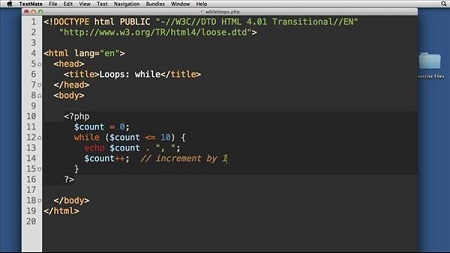
English | MP4 | AVC 1280×800 | AAC 44KHz 2ch | 14.5 Hours | 1.58 GB
PHP is a popular, reliable programming language at the foundation of many smart, data-driven websites. This comprehensive course from Kevin Skoglund helps developers learn the basics of PHP (including variables, logical expressions, loops, and functions), understand how to connect PHP to a MySQL database, and gain experience developing a complete web application with site navigation, form validation, and a password-protected admin area. Kevin also covers the basic CRUD routines for updating a database, debugging techniques, and usable user interfaces. Along the way, he provides practical advice, offers examples of best practices, and demonstrates refactoring techniques to improve existing code.
Topics include:
- What is PHP?
- Installing and configuring PHP and MySQL
- Exploring data types
- Controlling code with logical expressions and loops
- Using PHP’s built-in functions
- Writing custom functions
- Building dynamic webpages
- Working with forms and form data
- Using cookies and sessions to store data
- Connecting to MySQL with PHP
- Creating and editing database records
- Building a content management system
- Adding user authentication
Table of Contents
Introduction
001 Welcome
002 Using the exercise files
PHP Overview
003 What is PHP
004 The history of PHP
005 Why choose PHP
006 Installation overview
Mac Installation
007 Overview
008 Working with Apache Web Server
009 Changing the document root
010 Installing to Yosemite
011 Enabling PHP
012 Upgrading PHP
013 Configuring PHP
014 Installing MySQL
015 Configuring MySQL
016 Text editor
Windows Installation
017 Overview
018 Installing WampServer
019 Finding the document root
020 Configuring PHP
021 Configuring MySQL
022 Text editor
First Steps
023 Embedding PHP code on a page
024 Outputting dynamic text
025 The operational trail
026 Inserting code comments
Exploring Data Types
027 Variables
028 Strings
029 String functions
030 Numbers part one – Integers
031 Numbers part two – Floating points
032 Arrays
033 Associative arrays
034 Array functions
035 Booleans
036 NULL and empty
037 Type juggling and casting
038 Constants
Control Structures – Logical Expressions
039 If statements
040 Else and elseif statements
041 Logical operators
042 Switch statements
Control Structures – Loops
043 While loops
044 For loops
045 Foreach loops
046 Continue
047 Break
048 Understanding array pointers
User-Defined Functions
049 Defining functions
050 Function arguments
051 Returning values from a function
052 Multiple return values
053 Scope and global variables
054 Setting default argument values
Debugging
055 Common problems
056 Warnings and errors
057 Debugging and troubleshooting
Building Web Pages with PHP
058 Links and URLs
059 Using GET values
060 Encoding GET values
061 Encoding for HTML
062 Including and requiring files
063 Modifying headers
064 Page redirection
065 Output buffering
Working with Forms and Form Data
066 Building forms
067 Detecting form submissions
068 Single-page form processing
069 Validating form values
070 Problems with validation logic
071 Displaying validation errors
072 Custom validation functions
073 Single-page form with validations
Working with Cookies and Sessions
074 Working with cookies
075 Setting cookie values
076 Reading cookie values
077 Unsetting cookie values
078 Working with sessions
MySQL Basics
079 MySQL introduction
080 Creating a database
081 Creating a database table
082 CRUD in MySQL
083 Populating a MySQL database
084 Relational database tables
085 Populating the relational table
Using PHP to Access MySQL
086 Database APIs in PHP
087 Connecting to MySQL with PHP
088 Retrieving data from MySQL
089 Working with retrieved data
090 Creating records with PHP
091 Updating and deleting records with PHP
092 SQL injection
093 Escaping strings for MySQL
094 Introducing prepared statements
Building a Content Management System (CMS)
095 Blueprinting the application
096 Building the CMS database
097 Establishing your work area
098 Creating and styling the first page
099 Making page assets reusable
100 Connecting the application to the database
Using Site Navigation to Choose Content
101 Adding pages to the navigation subjects
102 Refactoring the navigation
103 Selecting pages from the navigation
104 Highlighting the current page
105 Moving the navigation to a function
Application CRUD
106 Finding a subject in the database
107 Refactoring the page selection
108 Creating a new subject form
109 Processing form values and adding subjects
110 Passing data in the session
111 Validating form values
112 Creating an edit subject form
113 Using single-page submission
114 Deleting a subject
115 Cleaning up
116 Assignment – Pages CRUD
117 Assignment results – Pages CRUD
Building the Public Area
118 The public appearance
119 Using a context for conditional code
120 Adding a default subject behavior
121 The public content area
122 Protecting page visibility
Regulating Page Access
123 User authentication overview
124 Admin CRUD
125 Encrypting passwords
126 Salting passwords
127 Adding password encryption to CMS
128 New PHP password functions
129 Creating a login system
130 Checking for authorization
131 Creating a logout page
Conclusion
132 Next steps
Resolve the captcha to access the links!